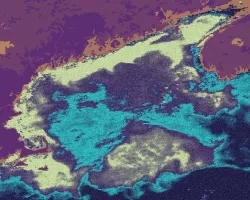Hawai'i climate (2024 Spring)
Team: Raz Wachtel (Project Lead), Danielle Sonobe, Mina Nada, Tyler Morgan
Summary: Hawaiian fishponds (loko i’a), ancient aquaculture systems created over 1500 years ago, historically served to harvest prized native fish species. Colonization-induced changes in land management have reduced active loko i’a from over 500 to ~20, destabilizing nearshore ecosystems and diminishing native Hawaiian cultural traditions. In recent decades, efforts to restore loko i’a have intensified as part of a broader emphasis on preserving Hawaiian cultural identity. Anthropogenic-induced climate change threatens these systems, particularly through the increase in frequency and magnitude of marine heatwaves. Though largely unexplored, these events are effectively studied utilizing remote sensing via Earth observations. Leveraging this technique enables autonomous extraction of water quality parameters to inform fishpond management. This study examined seven loko i’a across the main Hawaiian Islands (Hawai’i Island, Moloka’i, Maui, O’ahu, Kaua’i). Sea surface temperature and normalized difference chlorophyll index measurements were derived in fishponds utilizing Landsat 8 Thermal Infrared Sensor Thermal Infrared Sensor and Sentinel-2 MultiSpectral Instrument between 2013 to 2023, while regional patterns in temperature and chlorophyll-a were observed via Aqua’s Moderate Resolution Imaging Spectroradiometer (2002–2021). Employing these sensors, we focused analysis around the 2015 and 2019 marine heatwaves in the Pacific. We observed a heat stress gradient across the archipelago, creating thermally sheltered and unsheltered fishponds, yet identified no notable localized relationships between temperature and chlorophyll-a. Additionally, we applied pre-determined thermal maxima for culturally significant fish species (Striped Mullet: Mugil cephalus; Milkfish: Chanos Chanos) to assess historical habitat suitability within fishponds. While the direct impacts of marine heatwaves on loko i’a ecology are unknown, temperature patterns observed in this study are cause for concern.



